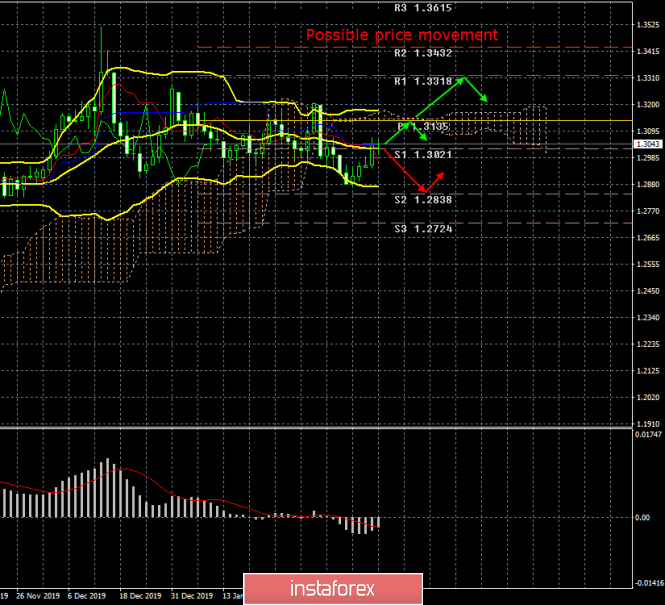24-hour timeframe

The British pound began to form a new downward trend, but a turn up and a round of upward correction began this trading week against the current weakest downward trend. Bollinger Bands are directed down, which so far retains the likelihood of a resumption of a downward trend. Also, the pound/dollar pair has not yet been able to cross the Kijun-sen line on the 24-hour chart, although it is very close to it. As we have already said, this week traders reacted not to macroeconomic statistics, but to political news from the British Parliament. And we believe that the pound once again shows growth when there is no reason at all for this. Over the past two years, this situation has been repeated regularly, the pound regularly rises in price on rumors that are not confirmed, on expectations, on various kinds of political messages. But macroeconomic statistics are just regularly ignored, as it was this week. The upcoming week will be much more interesting for the GBP/USD currency pair than for the EUR / USD pair, since there will be a sufficient amount of important data from Great Britain.
Monday will be completely empty in terms of macroeconomic statistics. There is absolutely nothing to pay attention to. President's Day will be celebrated in the United States on Monday. Therefore, you can proceed to Tuesday. On this day, the UK will publish average wage for December with and without bonuses, the unemployment rate for December, as well as the number of applications for unemployment benefits. No major changes in these indicators are expected. The unemployment rate is likely to remain at a fairly low level of 3.8%, the number of new applications for unemployment benefits will amount to 22,600, and the growth rate of wages can only slightly slow down. Thus, everything will depend on how much the real values of the indicators differ from the predicted ones.
A much more important consumer price index in the UK will be published on Wednesday, which, according to experts, could accelerate from 1.3% y/y to values ranging from 1.4% - 1.6% y/y. However, in monthly terms, inflation is likely to slow down by 0.5% - 0.6%, which, in fact, eliminates almost any positive effect from the annual value. Recall that the annual value is calculated relative to the same month last year. Thus, it turns out that the annual value can be at least +5%, but if negative inflation is recorded in monthly terms, this will mean that it will continue to slow down, and in the case of Great Britain, deflation can already be observed in monthly terms.
Great Britain will release retail sales reports for January, as well as a CBI report on changes in industrial orders. It is expected that the first indicator will show an increase of 0.4% in annual terms and in monthly terms. This is a good increase for the monthly, while it is very weak for the annual. The second industrial order indicator, presented by the Confederation of British Industrialists, is expected to remain in the negative zone, since the British industry continues to experience serious problems.
Britain is set to publish indices of business activity in the fields of services and production in the last trading week of the next week. In recent months, the index in the manufacturing sector has risen and returned to the area of 50.0 and higher, however it may again fall to the area below the key level of 50 by the end of February. According to forecasts, this indicator will decrease to the value 49.6 in February. As for the service sector, everything is more stable and positive here - forecasts for February are 53.2 - 53.4 with the previous value of 53.9. As you can see, a decline is expected everywhere.
In general, we believe that the British currency will have no supporting macroeconomic factors next week. Having studied all the macroeconomic reports, we came to the conclusion that most of them could fail again. Of course, special attention should be paid to inflation, if it accelerates, this can cause a wave of purchases of the British currency, but in general we do not see the prerequisites for the UK economy to accelerate and macroeconomic indicators to recover. From time to time, individual indicators grow (for example, the index of business activity in industry), but this looks like a correction, after which a new decline will inevitably follow. Thus, the Bank of England has many questions about the current state of the British economy, as well as to monetary policy, which, in our opinion, should have already been softened.
Trading recommendations:
The pound/dollar pair started an upward correction on the 24-hour timeframe. Thus, at the moment, for the 24-hour timeframe, it is recommended that you aim for 1.2838 and 1.2724 for the pound, if the bulls fail to overcome the Kijun-sen critical line. Shorts are still more relevant on the 4-hour timeframe, but there you should now wait until a dead cross forms before resuming to trade down.
Explanation of the illustration:
Ichimoku indicator:
Tenkan-sen is the red line.
Kijun-sen is the blue line.
Senkou Span A - light brown dotted line.
Senkou Span B - light purple dashed line.
Chikou Span - green line.
Bollinger Bands Indicator:
3 yellow lines.
MACD indicator:
Red line and bar graph with white bars in the indicators window.
The material has been provided by InstaForex Company - www.instaforex.com